PATAGONIA
Overview
Patagonia is about 400,000 square miles in Argentina and Chile (about the size of Texas and twice the size of Germany). About two-thirds or 260,000 square miles is in Argentina, which is about a quarter of the country. The northern border is the Colorado and Barrancas rivers. The southern border is the Straits of Magellan. It spans from the Atlantic to the Pacific. Some people include the island of Tierra del Fuego, which would increase the size by about 40,000 square miles.
Patagonia in Argentina has three districts: The Lake District (alpine mountains, lakes and villages), the Atlantic Coast (includes the Valdez Peninsula which has incredible marine life), and South with rugged mountains next to vast emptiness.
It is a far distance from north to south, as Bariloche is 1,350 miles from Ushuaia in Tierra del Fuego, which is the main embarkation point for Antarctica travel. The western highway is Route 40 (iconic like Route 66 in the US). The eastern highway is Route 3. The Andes Mountains separate Chile and Argentina. Besides the mountains, Patagonian Chile is largely islands and channels, while Argentina is characterized by wind-swept landscape with cattle and sheep the main inhabitants.
The Portuguese seafarer Fernando de Magallanes, while searching for a passage to the Pacific Ocean, named the indigenous people Patagones which meant “big feet” in Portuguese. No one knows exactly why he chose this name, but it could have come from his first encounter with the native Americans who were big people.
Regarding photography, the mountains of Patagonia are ready-made for awesome pictures. However, almost everyone goes there for only a few days and no one has control of the weather. Therefore, it is unlikely you will come back with a compendium of photos worthy of a coffee table book. But you probably will get some terrific ones, even with your phone. The important point is you saw and experienced the landscape.
Bariloche
After about a two and half hour flight to from Buenos Aires, we arrived in Bariloche (officially San Carlos de Bariloche) in the Lake District. After renting a car at the airport, we drove a quick forty miles on Route 40 to Pneuma Hue Estancia. The name means “place of dreams” in Mapudungun. It is an eco-lodge with five cabins, each with four or five rooms. It is 500 acres in the Nahuel Huapi National Park, on the shore of Lake Gutierrez and on the base of the Andean mountain range which includes Mt. Cathedral (7,835 ft. elevation), which looks like a medieval tower.
Our rooms were in the main lodge which serves breakfast and dinner (included in the price, but not drinks, lunch or snacks) and were $250 / night for room for two. The setting is dramatic, yet peaceful, featuring large Rocky Mountain-looking range within a fifteen-minute walk, a large blue lake with steam blowing off in the early morning, a variety of large trees with noisy birds, friendly horses eating apples and a family of black and white border collies roaming around.
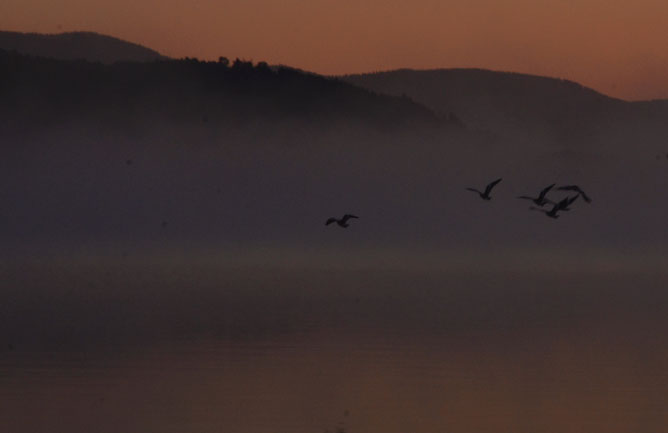
From pictures, we saw the place was even more striking in the fall when the trees were changing colors and in the winter with snow covered mountains. We stayed three nights, making hikes up to the continental divide and Jacuzzi waterfall. The hikes were moderate and steep in a few places. Round trip, not counting hanging out at the top, took about two hours.
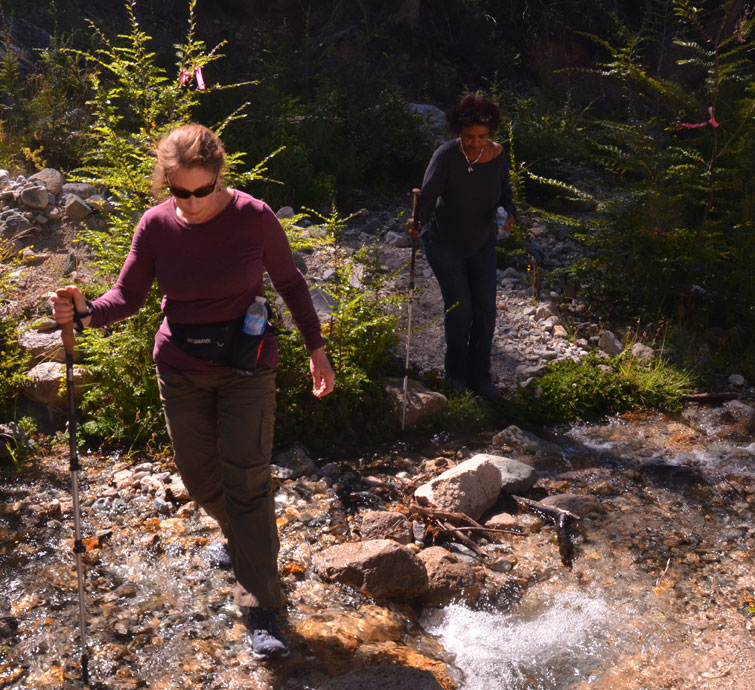
However, two other guests ran the trails, one was an incredible gentleman who had his 71st birthday at the lodge.
Before dinner, we had drinks with the other guests while waiting for dinner. This was a great time to exchange life stories, including valuable travel experiences. For instance, two of the parties had gone to Antarctica. Khadija and I absorbed some details and decided we should go within the next two years. One night, there were three parties (ours, another American one, and an Australian couple) and we decided to eat at the same table. Unfortunately, the conversation veered to the recent American presidential election and it became tense and uncomfortable. Pay attention to the adage “never discuss politics and religion in general company”. The next day, Nancy and I took an Iyengar yoga class at the lodge, which relieved the tension of the previous night’s dinner and loosen our limbs for more hiking.
While at the lodge one afternoon, Roger and Nancy arranged for a half day of fly fishing lessons. Khadija and I drove to El Bolson, which was about a 90-minute ride south on Route 40. It’s not hard to see why the hippies started flocking there, which is an elongated village in a large valley, back in the ’70s. It still retains that vibe, especially in the street market selling jewelry, clothing, souvenirs, local beer and food.
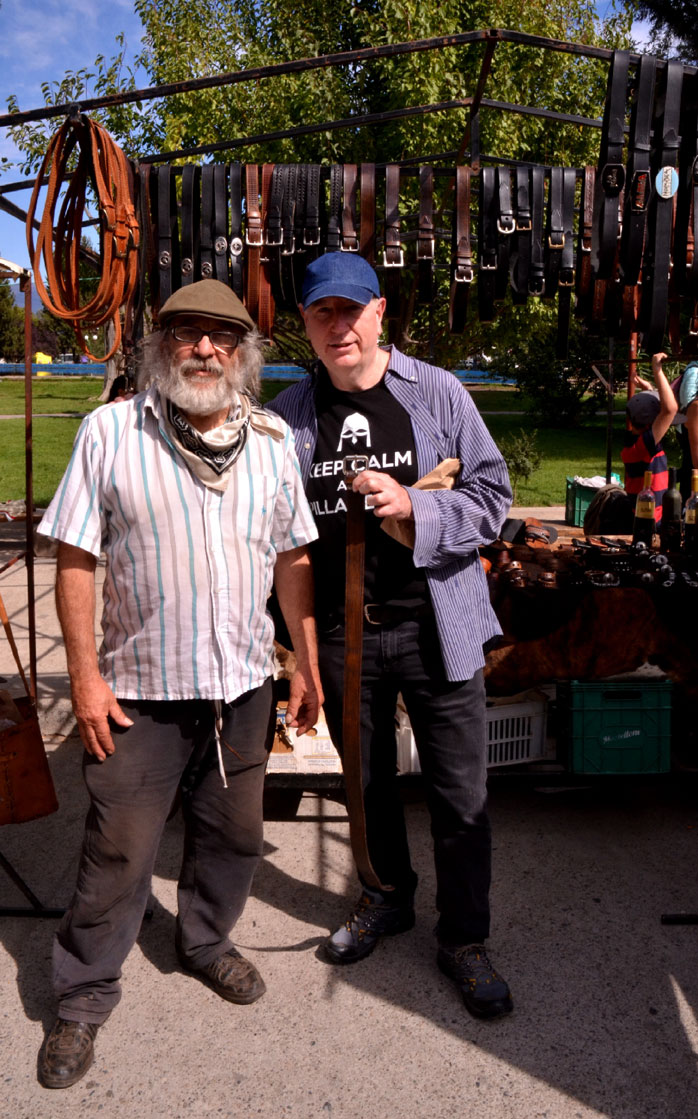
On our last night, we checked out in the afternoon, returned the car to the Bariloche Hertz office and stayed in the Hotel Tivoli for the night. It was a boutique hotel with great Wi-Fi and a good breakfast buffet. However, here and everywhere else, we found the scrambled eggs runny; it must be how they like it in this country. We walked around the city, which has some interesting Swiss-like architecture, but is mainly a mishmash of buildings that have rapidly grown without thoughtful zoning. We had dinner at El Boliche de Alberto. The beef and lamb we ordered were tasty and the portions immense, as in most parrillas. We spent about $100 for all four
Torre Del Paine (Chile)
The next day, we flew an hour and half south to El Calafate and rented the same model of Chevy from Hertz at the airport. We stopped in town to complete paperwork to drive to Chile with another Hertz office, had a quick meal and filled the gas tank. Not counting time at both sides of the border, it takes about three hours to reach the border. There is only one town in Argentina, so to speak, on the way called Esperanza. It has one large gas station, a few buildings and unnecessary and complicated bypass roads which could be the result of pork barrel spending. You must buy gas here, as there is no other station on the road to the park. Also, buy a road map here if you didn’t nab one in El Calafate, as a wrong turn could mean up to an hour of wasted time and gas.
During this drive, the terrain was desolate rolling hills with a few grazing sheep and scenic mountain ranges in the far distance. The border crossing of Don Guillermo in Argentina and Cerro Castillo in Chile each took about fifteen minutes to complete paperwork. We drove for an hour to the park and see its incredible mountain scenery.
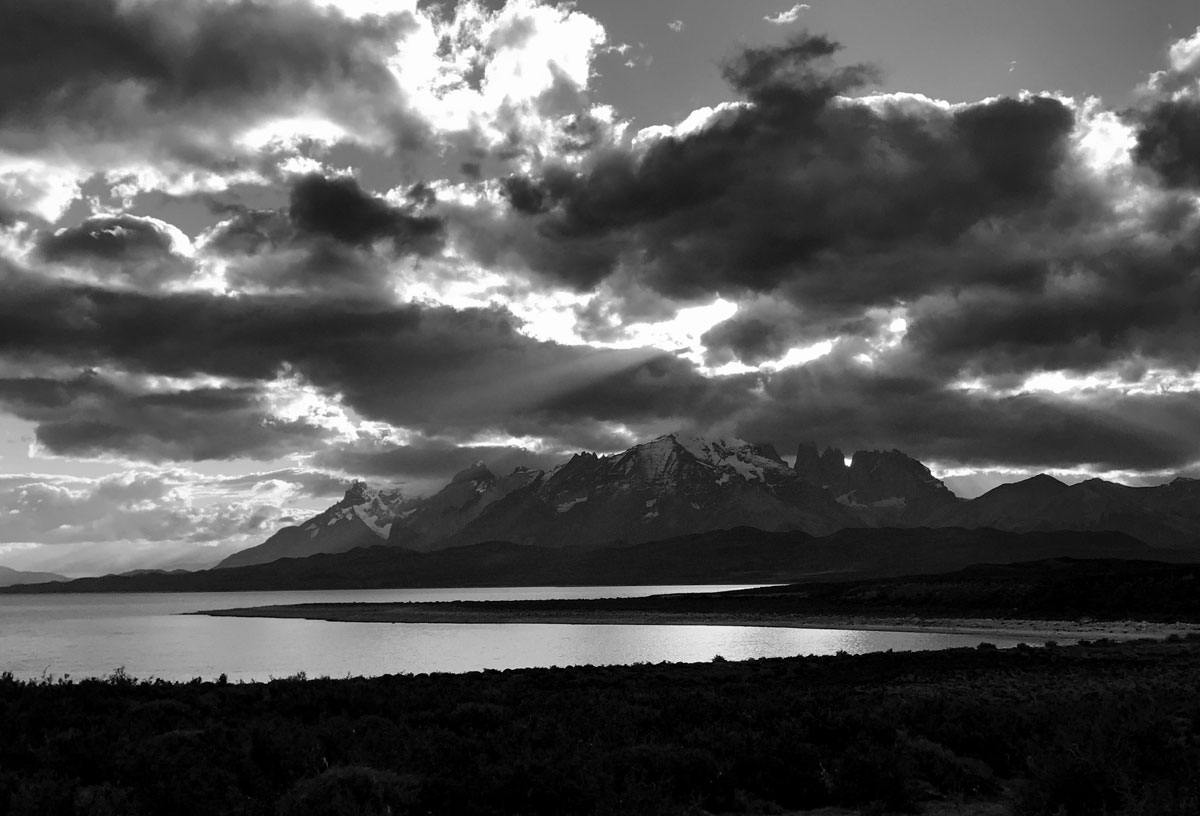
and active wild life (guanacos, rheas, rabbits).
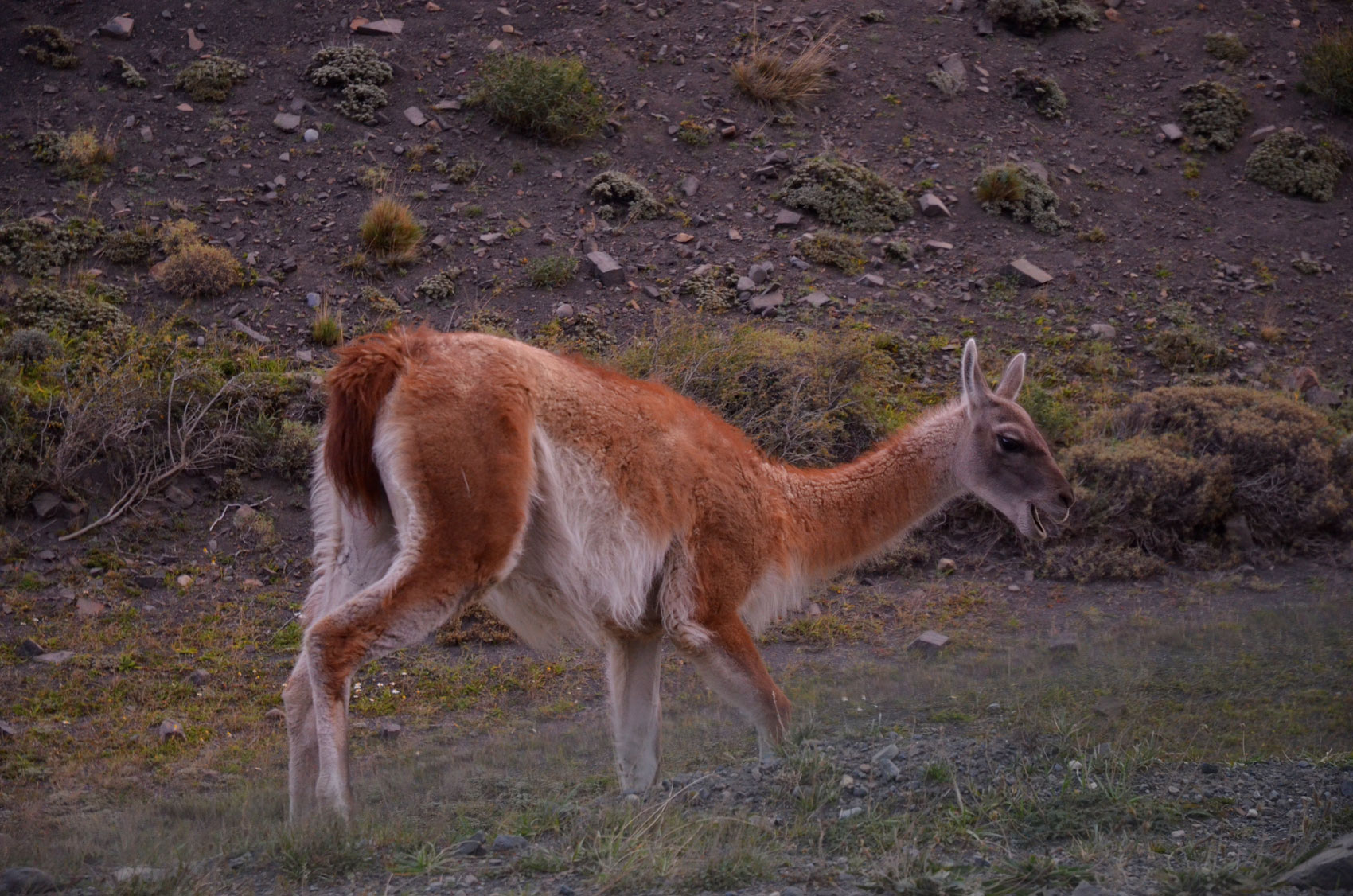
Then we drove an hour and half (cannot go too fast on the dirt roads) to Hotel Lago Grey with a stop to pay the entrance fee of C$21,000/person (about $30). It is important to keep in mind, we never passed a gas station on our drive since Esperanza, so watch your gas gauge.
Hotel Lago Grey is a thirty-six-room hotel, with sections connected by an elevated walk way, on the shore of a lake with floating ice bergs and spectacular craggy and rugged mountains intersected by the Grey Glacier. We stayed two nights at $350/night/room for two, with buffet breakfast.
Our first day we hiked the Mt. Ferrier Trail, starting about a half mile from the lodge, commencing at the National Forest Corporation (CONAF) cabin where you sign the log of hikers. It is a difficult hike, rising 700 meters (2,300 feet) and depending on what shape you are in, it usually takes four to five hours to the top and back.
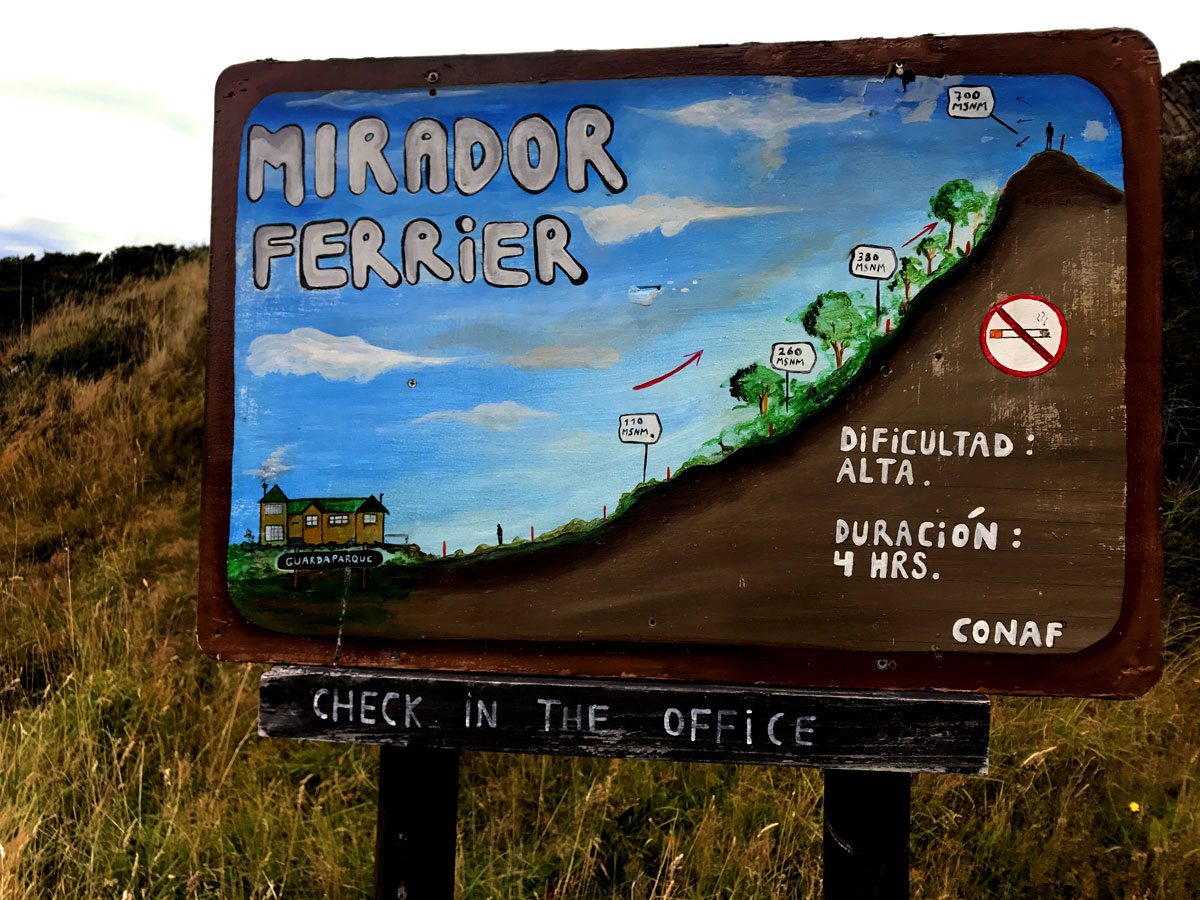
About a third of the way up, we saw outstanding views of the eastern park. At the top is intense wind, so strong that I had to get on my stomach at the edge, because I was afraid of being blown off!
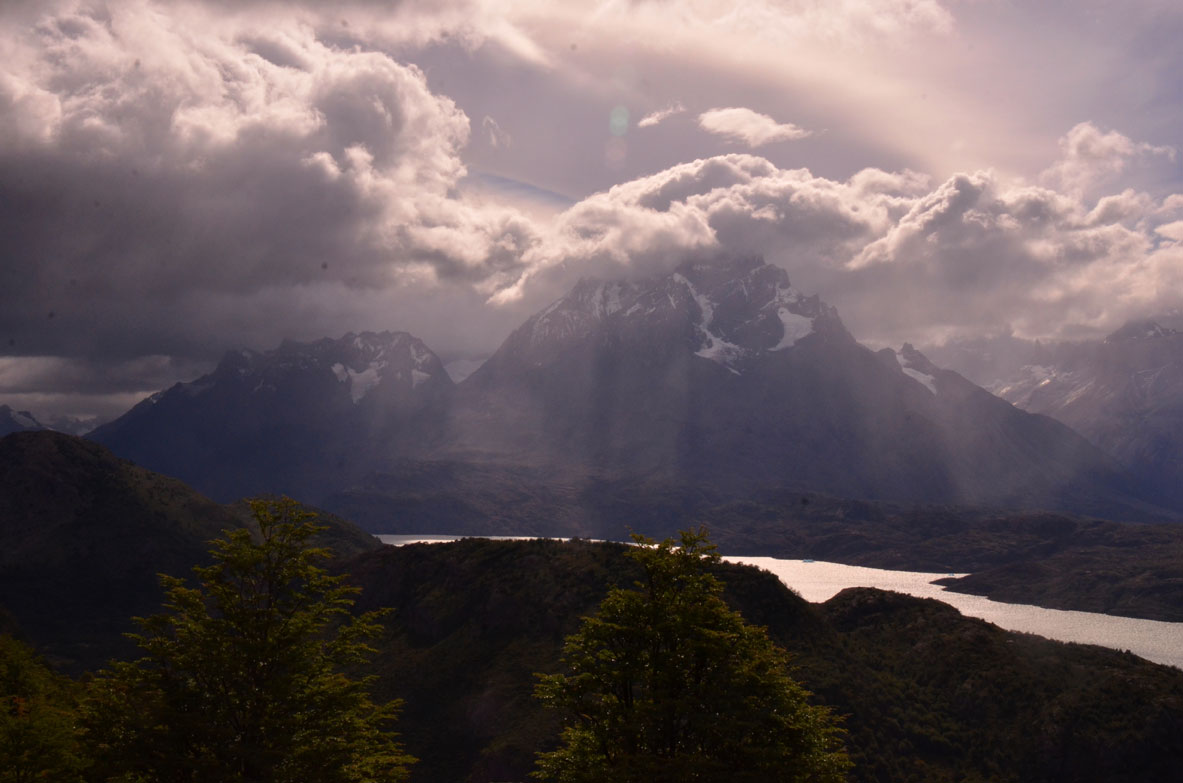
The next day we checked out after breakfast and drove through the park stopping at scenic outlooks. Each hotel has shuttles which will do this. If you drive, be careful. A passenger truck with park volunteers skidded off a bend in the road and flipped. They were extremely shaken, but no apparent major injuries. Our rental car insurance had a much higher deductible for overturning a car, apparently because how frequently it happens.
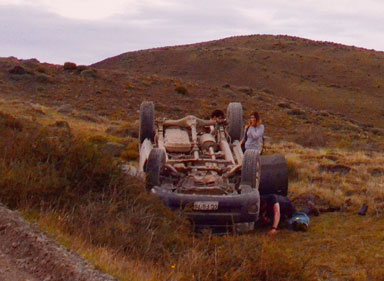
When we got to the western part of the park, we could clearly see the iconic Torres del Paine; the massive granite pillars dominating the mountain range. These are so magnificent, it was worth the trip just to see them.
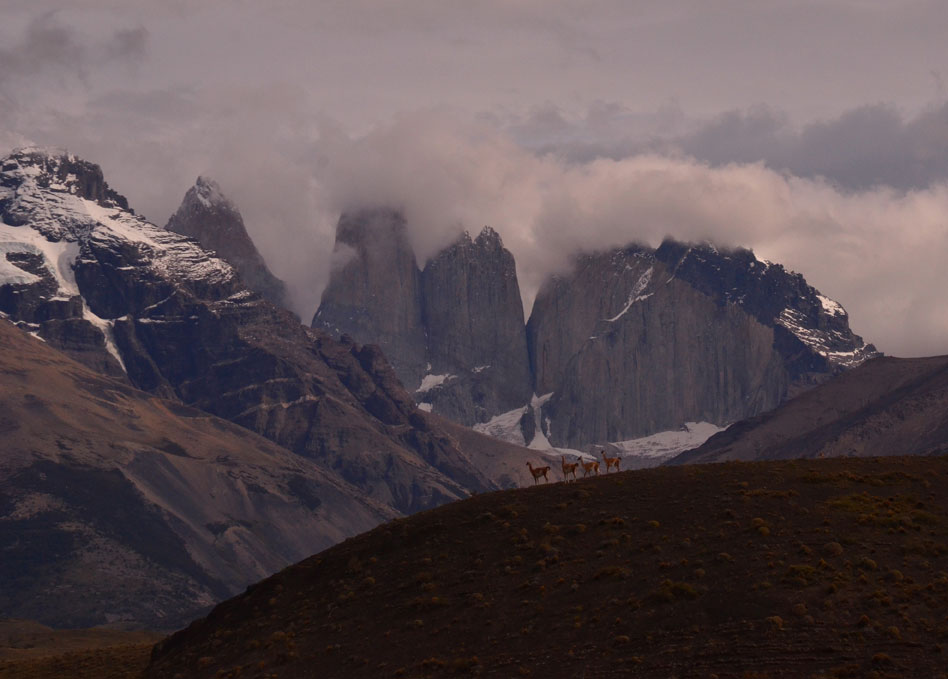
We ended our drive at Laguna Azul, which provided a great lake view of the towers with grazing guanacos, ducks and horses, as well as roaming foxes. We then retraced our path on the dirt roads to drive to Hotel Rio Serrano. This hotel is more on the outskirts of the park, but has a fabulous view of the mountains. Our one night cost for a room for two, with drinks and a buffet dinner not included in the rate, was $688. I spent two hours in the morning photographing as the sun was rising and shedding soft, pleasing light.

After breakfast, we bought some gas from a local resident and drove back to El Calafate (watching our gas of course). At a café at Cerro Castillo, we saw the best sign of the trip.

El Calafate and Glaciers National Park
El Calafate, on the shore of Lago Argentino, is the base for exploring most of Glaciers National Park. It is still a small town that has grown dramatically from tourism. The downtown is primarily one long street named Av del Libertador General San Martín (known as Libertador) and it was filled with tour operators, outdoor clothing and supplies stores, hotels, souvenir, art and jewelry shops and many restaurants and bars. The downtown architecture is between rustic and strip mall, but with some charm.
 Some of the older homes in the city looked like they could belong on a prairie, including some small A-frame houses.
Some of the older homes in the city looked like they could belong on a prairie, including some small A-frame houses.

The newer homes on the outskirts looked like a new development in Sedona, Arizona – large and sprawling, located on hills with good views.
We ate at a good and well known asado, La Tabilta, Calle Cnel de Marina Rosales 28, with the obligatory gigantic meat portions.
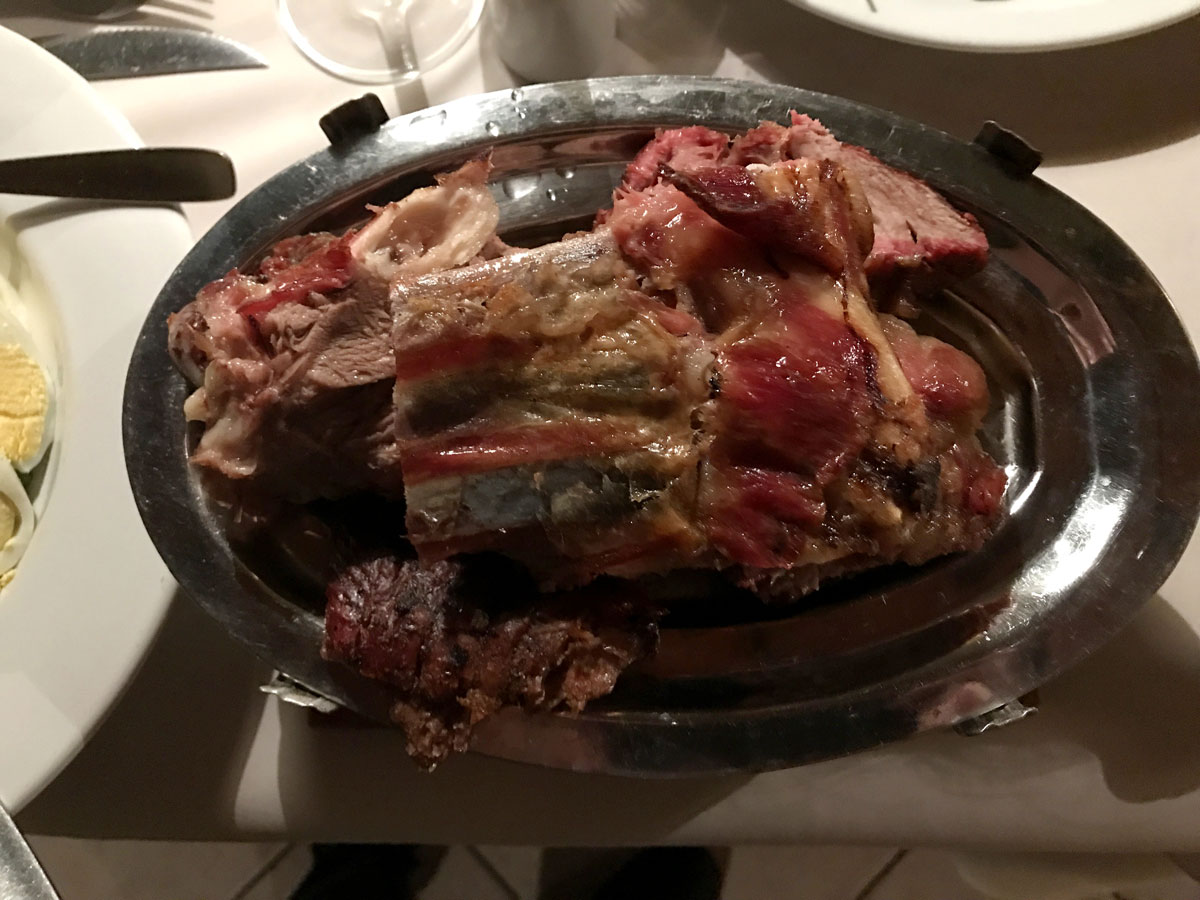
With drinks, appetizers and side dishes, it cost about $40/person. We also stopped in Cerveceria Chopen, Libertador 1630, an inexpensive microbrewery with light dishes and a fun and laid back vibe. For three nights we stayed at Design Suites, Calle 94 N 190 Playa Lago Argentino, for about $150/night for a room for two and buffet breakfast. The hotel had good views of the lake, excellent reception staff and friendly restaurant servers. However, it was a taxi ride from downtown, which was an inconvenience. The physical plant was in poor shape, with large cracks in windows, a gym where only the free weights worked correctly and the smell and humidity of the pool permeating the building.
Walking through town was a good way to relax and kill time. In the center, there is a small walkway perpendicular to the sidewalk with artist booths on each side. We were there on March 24, which is the “Day of Remembrance for Truth and Justice”, commemorating the victims of the “Dirty War”. Attached to wires overhead were paper cutouts representing diapers, each with a name of a “disappeared” from the Santa Cruz Province.
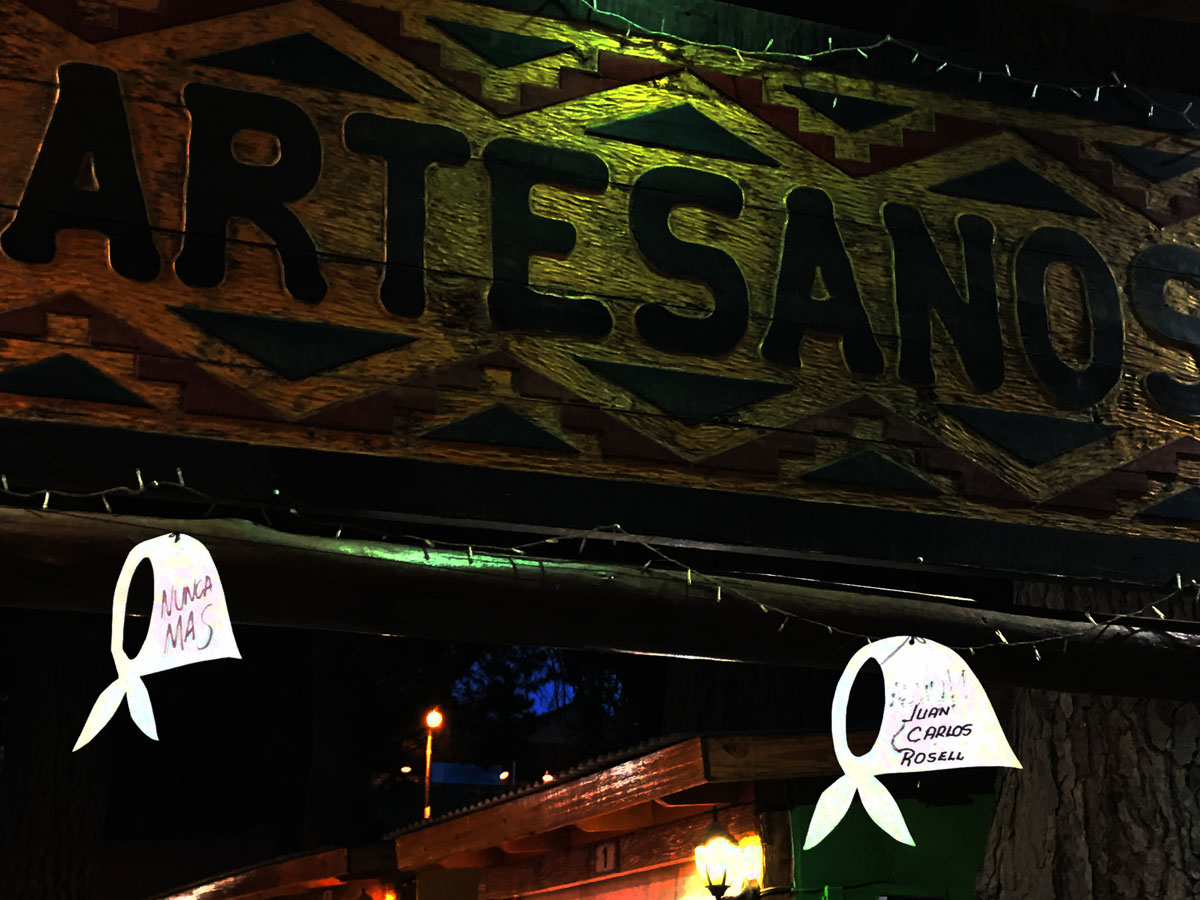
One day we drove to the Perito Moreno Glacier in Glaciers National Park, about an hour highway drive from El Calafate. There are tours to the glacier which allow you to walk on the ice on crampons, but the operator did not have places for our last-minute request. The admission to the park is about $30/person. Once in the park, it is another fifteen minutes to the parking lot. Then it is a short walk to extensive catwalks to observe the glacier.
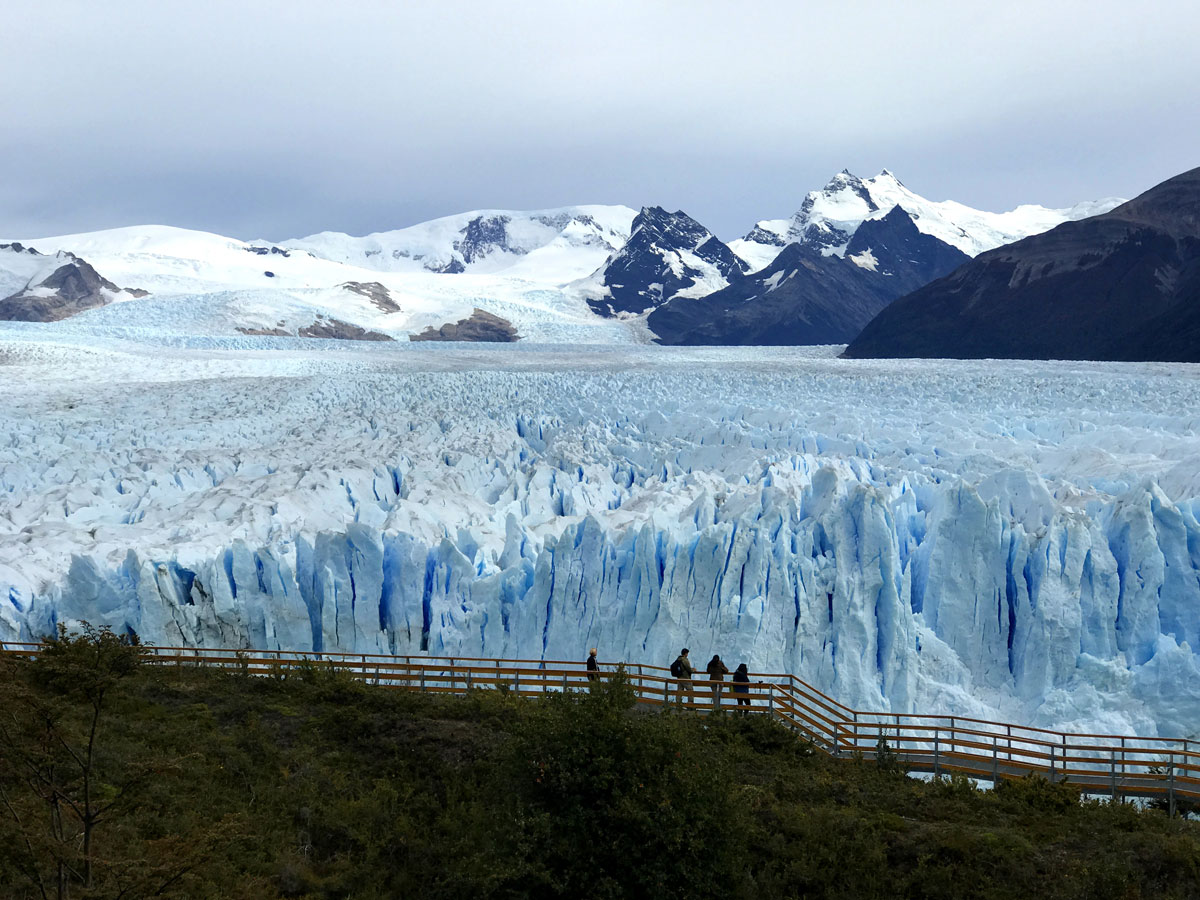
It unusual to easily come so close to a glacier of this size, 19 miles long, 100 square miles and over 2,000 feet at its deepest. At the tip, by the catwalks, it is 3 miles wide. The glacier is noisy with constant grinding movements as the ice shift and sounds comparable to blasting cannons when the ice falls into the water. This glacier is unusual in our global warming environment, as it is in an equilibrium or even slightly advancing. A good explanation of why it is not receding is in http://news.nationalgeographic.com/news/2009/06/090622-glaciers-growing.html.
Every two to five years, there is a gigantic rupture at the tip, which is spectacular to see if you are lucky enough to be there when it happens. The calving ice rises the waters of Lago Argentino, one of the biggest lakes in South America, as much as 100 feet. The last rupture happened March 10, 2016.
The highlight of our Glaciers National Park was a three day and two night stay in Estancia Cristina. We were picked up in a bus from our hotel at 7:30am. After stopping at a few more hotels, we were driven to Punta Bandera to board a passenger boat for about hundred people. It is a two-hour voyage in Lago Argentino to the Estancia. Going there takes another hour to see the Upsala Glacier and the floating blue icebergs.
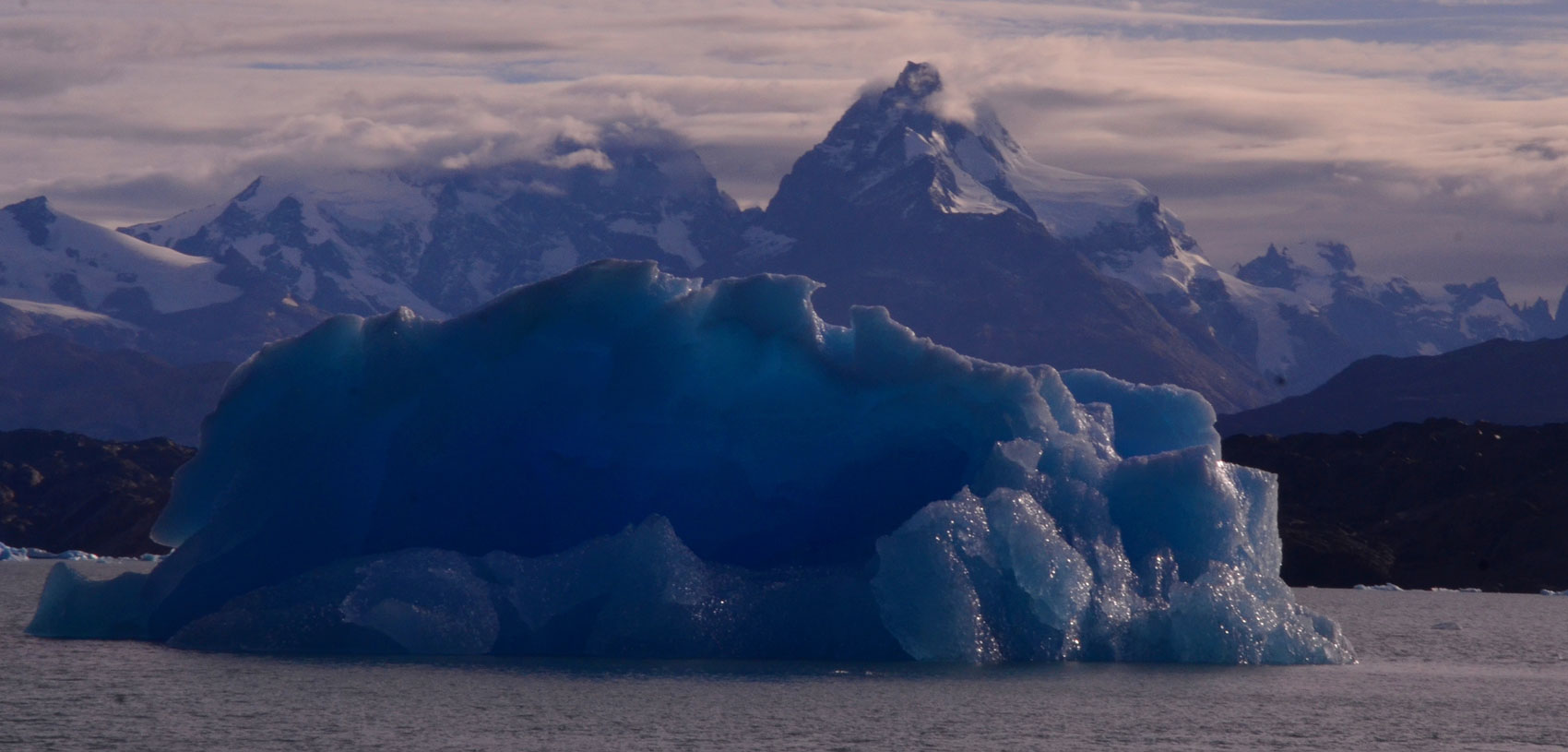
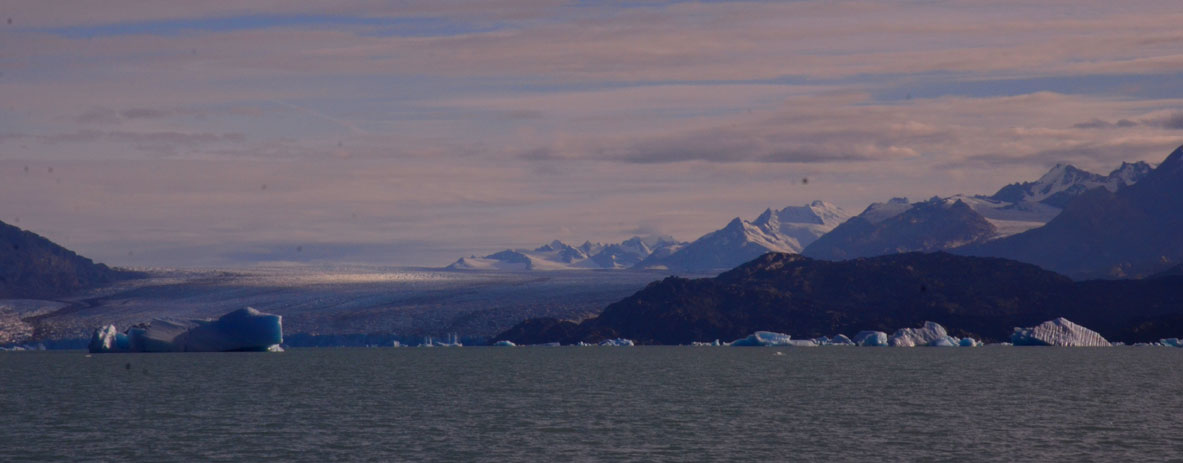
The lodge is a flat area between the lake and rugged mountains. Our rate was $1600 for two nights / room / two-persons, which included the transfers in/out of Punta Bandera, sailing an extra hour to the Upsala Glacier (with large, floating, blue ice bergs all around), all activities, meals, non-alcoholic beverages and a great view from the room.
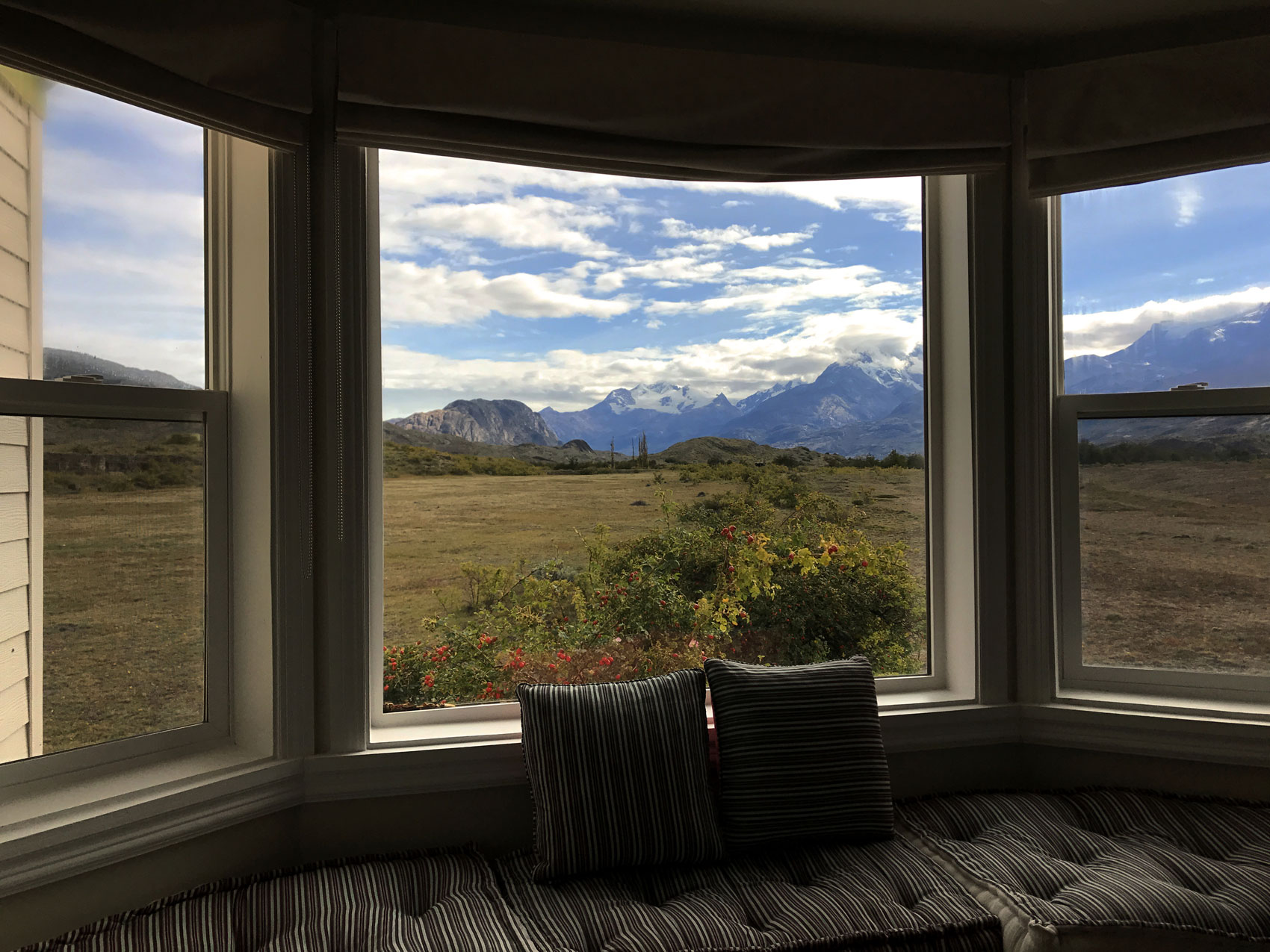
The most memorable part was our guided 4X4 six-mile drive up the mountains through a landscape that until recently was covered by glaciers. As we were the only guests then, there was no one else with us as we left at 8:30am (the estancia’s boat brings people for day drips from noon to 5pm.) When we reached the top and parked, we walked across a striking rocky stretch will fossil prints.
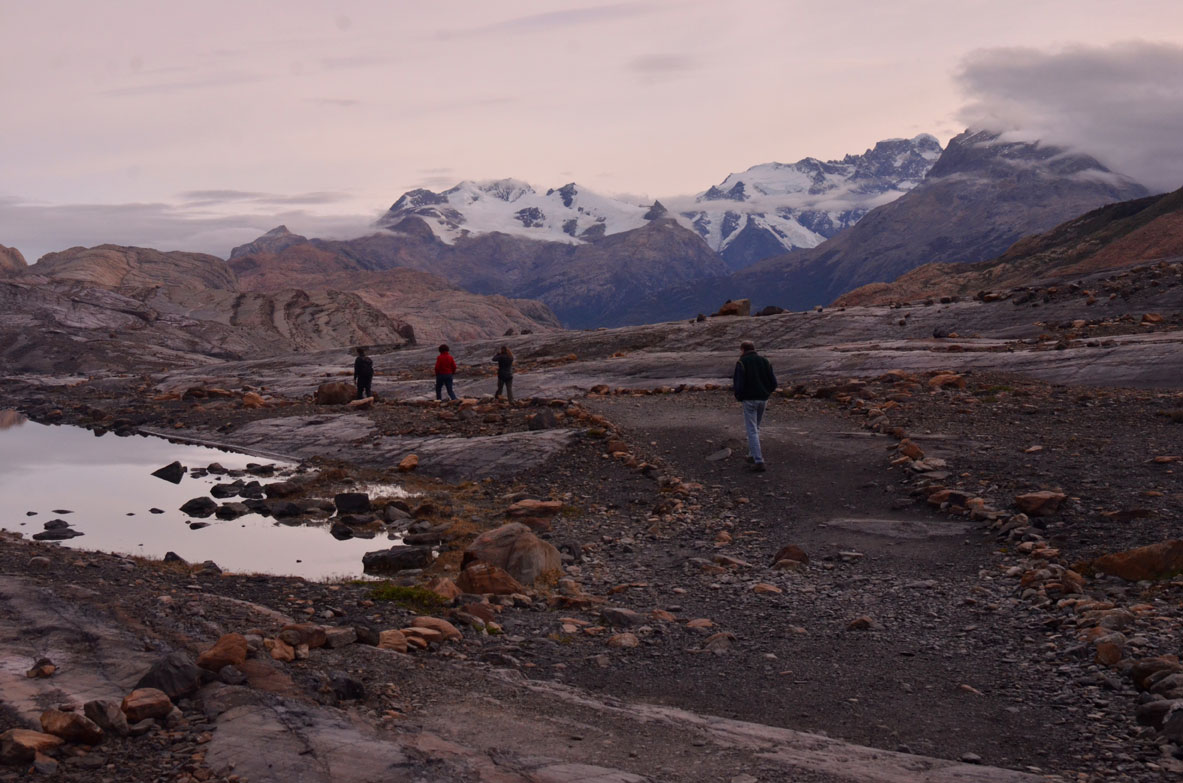

There was no wind and the ponds were still and reflective. There were few clouds in the soft early morning light, which provide an outstanding view of the Upsala Glacier, about three miles away. This glacier is the biggest in South America (approximately 350 square-miles, thirty-five-miles long and 250 feet high).
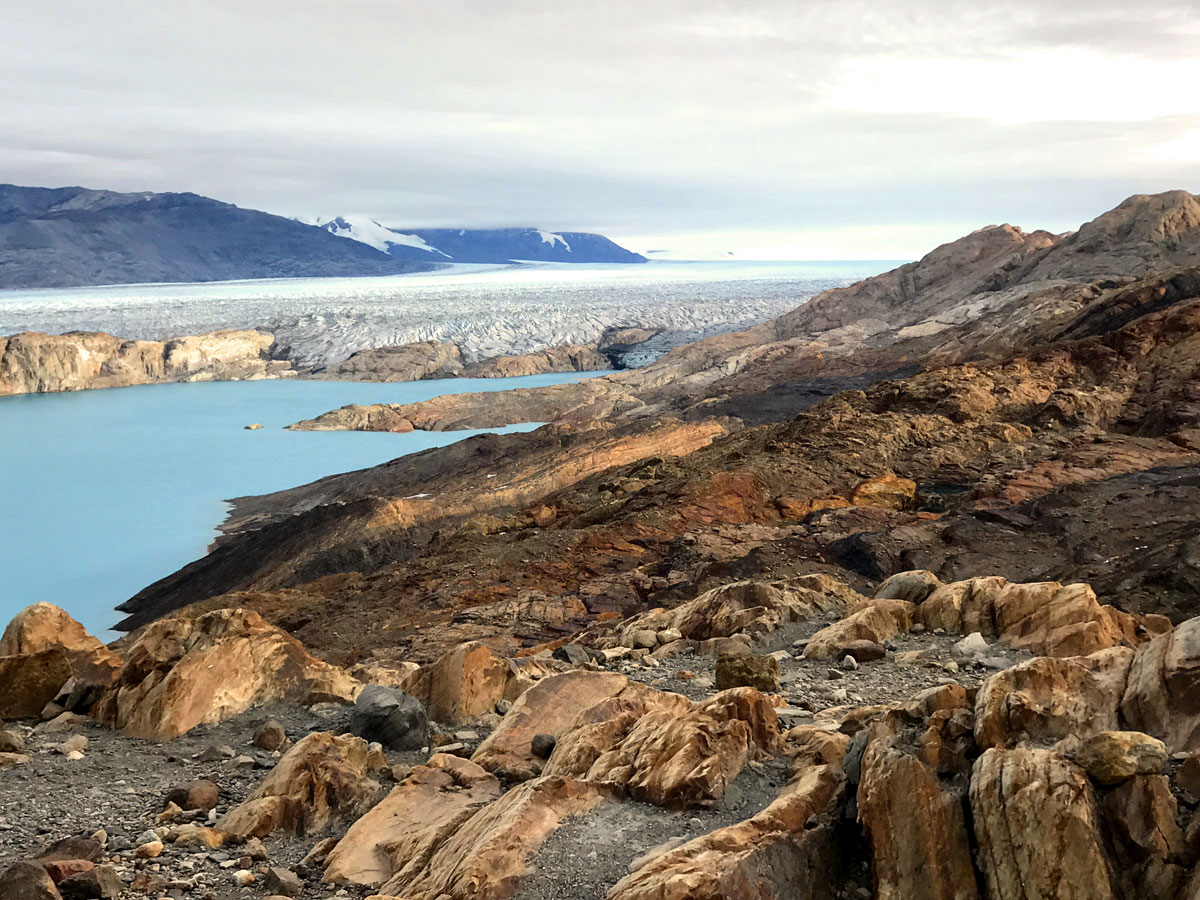
Unfortunately, it is known for its dramatic receding. According to our guide Mauricio, it has receded 18% in the last thirty years, which is a blink of an eye in geological terms. It was so calm at the peak, which infrequently happens because of the wind, that we observed a long spell of silence to appreciate the wonder before us.
While we Cristina, we hiked to a waterfall, visited a tiny chapel, walked by a salmon spawning river (they come all the way from the Atlantic) and toured the family museum. We also went on a slow horseback ride with a guide by the river on an established trail that the horses have done hundreds of times. We rode at such a slow pace (none of us had much experience), it felt like a kiddie park ride. However, with horses you always must be alert. Something spooked Khadija’s horse and she was thrown off. It took her a few minutes to catch her breath and about ten minutes to get up. We were all worried, but she seemed alright, although her arm still hurt a month later. She is lucky that she did have a serious injury. Being a good trooper, she composed herself, mounted the horse and completed the course.

Mt. Fitzroy was something I wanted to see in Glaciers National Park. However, it is accessible from El Chalten, which is over a three-hour drive from El Calafate. So, this will be on the itinerary the next time I come to Patagonia. On our last day, Khadija and I went north, while Roger and Nancy went south to Ushuaia.

